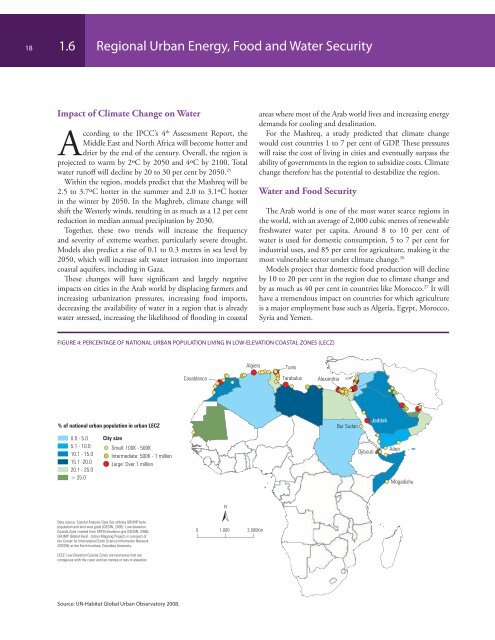The state of Arab Cities 2012/2013
The state of Arab Cities 2012/2013
The state of Arab Cities 2012/2013
Create successful ePaper yourself
Turn your PDF publications into a flip-book with our unique Google optimized e-Paper software.
181.6Regional Urban Energy, Food and Water SecurityImpact <strong>of</strong> Climate Change on WaterAccording to the IPCC’s 4 th Assessment Report, theMiddle East and North Africa will become hotter anddrier by the end <strong>of</strong> the century. Overall, the region isprojected to warm by 2ºC by 2050 and 4ºC by 2100. Totalwater run<strong>of</strong>f will decline by 20 to 30 per cent by 2050. 25Within the region, models predict that the Mashreq will be2.5 to 3.7ºC hotter in the summer and 2.0 to 3.1ºC hotterin the winter by 2050. In the Maghreb, climate change willshift the Westerly winds, resulting in as much as a 12 per centreduction in median annual precipitation by 2030.Together, these two trends will increase the frequencyand severity <strong>of</strong> extreme weather, particularly severe drought.Models also predict a rise <strong>of</strong> 0.1 to 0.3 metres in sea level by2050, which will increase salt water intrusion into importantcoastal aquifers, including in Gaza.<strong>The</strong>se changes will have significant and largely negativeimpacts on cities in the <strong>Arab</strong> world by displacing farmers andincreasing urbanization pressures, increasing food imports,decreasing the availability <strong>of</strong> water in a region that is alreadywater stressed, increasing the likelihood <strong>of</strong> flooding in coastalareas where most <strong>of</strong> the <strong>Arab</strong> world lives and increasing energydemands for cooling and desalination.For the Mashreq, a study predicted that climate changewould cost countries 1 to 7 per cent <strong>of</strong> GDP. <strong>The</strong>se pressureswill raise the cost <strong>of</strong> living in cities and eventually surpass theability <strong>of</strong> governments in the region to subsidize costs. Climatechange therefore has the potential to destabilize the region.Water and Food Security<strong>The</strong> <strong>Arab</strong> world is one <strong>of</strong> the most water scarce regions inthe world, with an average <strong>of</strong> 2,000 cubic metres <strong>of</strong> renewablefreshwater water per capita. Around 8 to 10 per cent <strong>of</strong>water is used for domestic consumption, 5 to 7 per cent forindustrial uses, and 85 per cent for agriculture, making it themost vulnerable sector under climate change. 26Models project that domestic food production will declineby 10 to 20 per cent in the region due to climate change andby as much as 40 per cent in countries like Morocco. 27 It willhave a tremendous impact on countries for which agricultureis a major employment base such as Algeria, Egypt, Morocco,Syria and Yemen.FIGURE 4: PERCENTAGE OF NATIONAL URBAN POPULATION LIVING IN LOW-ELEVATION COASTAL ZONES (LECZ)AlgiersTunisCasablancaTarabulusAlexandria% <strong>of</strong> national urban population in urban LECZBur SudanJeddah0.0 - 5.05.1 - 10.010.1 - 15.015.1 -20.020.1 - 25.0> 25.0City sizeSmall: 100K - 500KIntermediate: 500K - 1 millionLarge: Over 1 millionDjiboutiAdenMogadishuN0 1,000 2,000KmSource: UN-Habitat Global Urban Observatory 2008.


